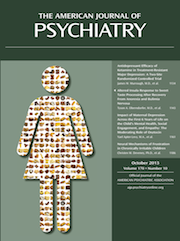Treatment-resistant depression is a significant clinical problem with great morbidity and mortality (
1). The report by Murrough et al. (
2), published concurrently with this editorial, of their two-site randomized controlled clinical trial of ketamine in patients with treatment-resistant depression is an exciting and important step in evaluating a new and promising approach for these patients. Should our desire as clinicians to help these often desperate patients propel us to adopt ketamine now, or do we need to know more before proceeding? More studies, or change practice now? Let’s take a look.
The effect of ketamine on treatment-resistant depression appears to be both quick and quite substantial. Overall, two-thirds (64%) of the patients in the trial of Murrough et al. (
2) responded, and about one-third (number needed to treat, or NNT, 2.8) responded
specifically to ketamine, which is a large effect size. By way of comparison, the NNT in placebo-controlled phase 3 Food and Drug Administration registration trials is 6–7 in depressed outpatients who are
not treatment resistant. About half of those in the Murrough et al. study who responded to ketamine relapsed over the next week—apparently without a sharp increase in suicidal ideation. Distressing adverse events were encountered on both the day of and the day following the infusion—including anxiety, which might raise the risk of suicidal thinking. Overall, eight of the 47 patients who received ketamine (17%) had significant dissociative symptoms, which could be quite disturbing to persons with borderline personality disorder. Blood pressure in the ketamine group rose from 122/72 mm Hg (pretreatment) to 141/81 (40 minutes after infusion), and two subjects required their infusions to be stopped for hemodynamic reasons. Other adverse effects were reported.
We do not know who responds to ketamine and who does not. An intriguing suggestion from Laje et al. (
3), noted by Murrough et al. in their discussion, is that some of those patients who do not respond to ketamine are carriers of a Val66Met (rs6265) single-nucleotide polymorphism (SNP) that is associated with an attenuation of brain-derived neurotrophic factor (BDNF) functioning).
How certain and generalizable are the findings from this report? The internal validity of the study might be challenged since the subjective effects of midazolam are likely to be quite different than those of ketamine. If blinding was incomplete, the NNT might be larger. On the other hand, the overall study results were comparable at the two individual sites. Furthermore, as Murrough et al. note, additional studies of ketamine in treatment-resistant depression that provide similar response rates or effect sizes have been reported.
While certainty of the results is seemingly high, generalizability is much more limited since the inclusion and exclusion criteria were quite selective and properly so. Only 73 of the 116 screened participants entered the study. Those with acute suicidal risk, history of psychosis, unstable general medical conditions, substance abuse in the last 2 years, abnormal ECGs, or various other features were excluded.
In patients with nonresistant depression, we know that over three out of four who do receive antidepressant medication in practice are excluded from well-designed, internally valid randomized placebo-controlled phase 3 trials (
4). The inclusion and exclusion criteria in the trial of Murrough et al. (
2) were at least as, if not more, restrictive than those in the usual phase 3 trials. Perhaps only one in four patients with treatment-resistant depression in practice would have been eligible to enter this particular trial. Consequently, we do not know whether ketamine is safe or effective in a wider, more representative group of patients with treatment-resistant depression for whom ketamine is likely to be used. Potential risks in this wider group include exacerbation of prior or even concurrent psychiatric or general medical conditions—borderline personality disorder, posttraumatic stress disorder; bipolar spectrum disorders, substance abuse, cardiovascular problems, etc.
Additional practical issues loom. For example, all of the subjects in the trial of Murrough et al. were medication free for at least 7 days (28 days for fluoxetine) prior to the ketamine infusion. In practice, the acquisition of a 7-day medication-free state in patients with treatment-resistant depression is very challenging given the exigencies of practice and restrictive coverage policies. The effects of ketamine when used in patients who are taking other psychotropic agents represents an unexplored risk in ketamine treatment of patients with treatment-resistant depression.
In addition, how to manage those patients who both do and do not respond to ketamine is unknown but very important. Do the previously ineffective antidepressant medications now work in ketamine responders, so that the follow-on treatment is a return to these medications? Are repeated ketamine infusions called for in the nonresponders or responders? Do they work?
While we lack several key pieces of information that are needed before we revise practice, this study does take several important steps: 1) it provides strong clinical evidence that the pathways targeted by ketamine deserve greater investigation and should be targets for drug development; 2) it suggests that some SNPs may usefully
exclude at least some patients with treatment-resistant depression from ketamine infusion, which is an important step in targeting treatment (
5); and 3) it suggests that
with informed consent, a wider range of patients with treatment-resistant depression should be studied under controlled circumstances to better identify those who should and
should not get ketamine—whether because of lack of efficacy or because of side effects. Multisite registries using an open design or point-of-care randomized trial designs (
6) could be a rapid way to move the field forward at lower costs to elaborate on the risks as well as the pretreatment predictors of ketamine treatment.
While insufficient to recommend a wholesale change in practice presently, these results certainly provide substantial hope for patients with treatment-resistant depression, insight into the biology of this condition, and a major obligation by clinician scientists and funding agencies to answer this next set of important clinical questions for our patients with refractory depression.

